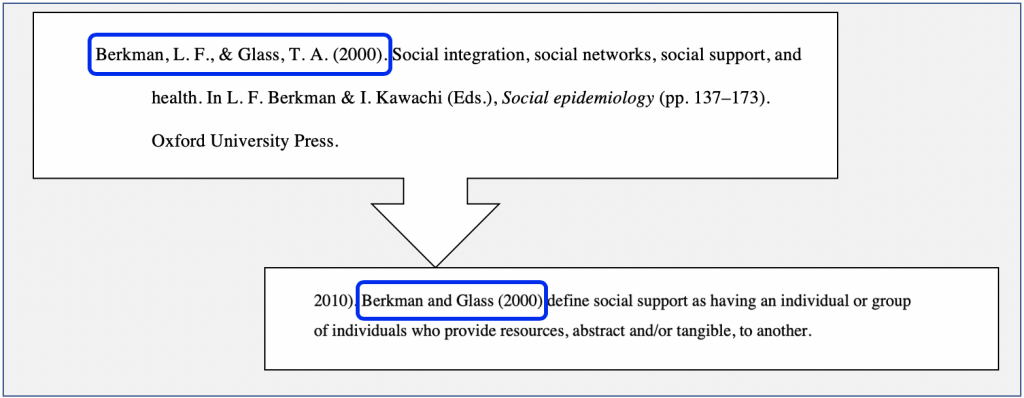8.12 – What is an In-Text Citation?
Learning Objective
After completing this chapter, you will be able to:
- Create and format in-text citations in APA Style.
You find a great idea or argument in a source that supports your topic and you want to include it. To do this you need to create an in-text citation and add it to your paper where you have discussed evidence from that source, either as a direct quote or a paraphrase. In-text citations tell your reader which ideas belong to you and which ideas belong to someone else.
Watch APA in-text citations on YouTube (9 mins)
Video source: Georgian College Academic Success. (2022, August 19). APA in-text citations [Video]. YouTube. https://www.youtube.com/watch?v=BNv44tAt9PA
There are two different ways that you can include in-text citations into your assignments: as a parenthetical citation or as a narrative citation.
Parenthetical vs. Narrative Citations
The following example (Figure 1 ) shows how these two types of in-text citations have been included in a paper. Click on the ![]() symbol to learn about them.
symbol to learn about them.
Figure 1: Two types of in-text citations included in a paper
- Citing Multiple Sources of the same information: Each work is separated with a semicolon and ordered alphabetically, like in this example: (Betoret, 2006; Perrier et al., 2010).
- Parenthetical In-Text Citation: (Betoret, 2006; Perrier et al., 2010). This is a parenthetical in-text citation where the writer has paraphrased a common idea from two different works. It’s inserted after the paraphrased sentence and before the ending punctuation. The parenthetical citation format for a work is: the family name or group name of the author(s), a comma, and the publication year all in parentheses.
- Narrative In-Text Citation: “Berkman and Glass (2000) define social support as having an individual or group of individuals who provide resources, abstract and/or tangible, to another.” This sentence has a narrative in-text citation that is paraphrased. It is formatted with the author’s family name within the paper’s narrative directly followed by the year in parentheses.
Figure 2: An infographic showing the two types of in-text citations: parenthetical and narrative
Figure 2 below provides an overview of these two types.

- Parenthetical citations include the author’s family name, year in parentheses at the end of a sentence. Example: … virtues of wit (Smith, 2010).
- A narrative citation includes the author’s family name as part of the sentence followed by the year in parentheses or as part of the narrative. Example: Smith (2010) discusses how…
The year may also be included as part of the narrative. Example: In 2010, Smith noted that…
Formatting an in-text citation
As you can see, an in-text citation is formatted using three key pieces:
- Parentheses,
- Author’s family name or group name, and
- Year.
In-text citation information is pulled directly from its matching reference list citation. So, it is easiest to create the reference citation first and then its matching in-text citation, as in Figure 3.
Figure 3: Reference page entry vs. narrative in-text citation

- A reference page entry for authors Berkman, L. F., & Glass, T. A., (2000) is compared to the coordinating in-text citation that you would use in your paper. While the reference page entry contains all information about the source, the narrative citation in your paper that points to this reference page entry would be written with just the author’s surnames and the year in the format: Berkman and Glass (2000) …
So far we have focused on paraphrasing examples. So next, we’re going to look at quotation examples for in-text citations.
When you use a direct quote instead of a paraphrase, you also need to include the quote’s location in the work. Additionally, when you paraphrase specific passages in longer-length works, you include the location. Location information is added to your in-text citation directly after the date. For example, a parenthetical citation would look like: (Smith, 2010, pp. 3-4).
For the following quotation examples, click on the ![]() symbol to learn about how to add in-text citations for short quotes and block quotes.
symbol to learn about how to add in-text citations for short quotes and block quotes.
Short Direct Quote In-Text Citation Examples
Figure 4: Narrative Citation
- Example text: While acknowledging the importance of culture, Tronick (2007), a developmental child psychologist, satirically notes that, “Culture is often referred to, even deferred to, but only superficially and rarely well” (p. 6). If we take Tronick’s…
- This is a narrative in-text citation (Tronick, 2007) for a short direct quote. For short quotes, they are included in your papers as part of the narrative and must be less than 40 words.
- The general format of a narrative in-text citation for a short quote is:
- an introductory phrase that includes the author, followed by the year in parentheses: Tronick (2007), a developmental child psychologist, satirically notes that,
- the quote in quotations: “Culture is often referred to, even deferred to, but only superficially and rarely well”
- location information in parentheses, followed by ending punctuation: (p. 6).
Figure 5: Parenthetical Citation
- Example text: … children are better at showing than telling. “When viewed from this perspective, toys are used like words by children and play is their language” (Landreth, 1991, p. 14). Hence, play offers a glimpse into a child’s mind.
- This is a parenthetical citation for a short quote. The parenthetical citation (Landreth, 1991, p. 14) is inserted after the quote and includes the author’s family name or group name, year, and page number. The ending punctuation follows after.
Block Direct Quote In-Text Citation Examples
Figure 6: Block Direct Quote – Narrative Citation
- Example text: Court decision ruling outlawing racial school segregation. Clark (1955) noted:
One of the most characteristic and impressive things about the American people are their dedication to their children … Almost no sacrifice is too great for parents to make if it will benefit their children. Parents will work, scheme, attend church, buy life and endowment insurance, move from country to city, from city to Suburbs, from one neighborhood to another, from south to north, from east to west – All for the welfare of their children. (p. 3)
- This narrative block quote example is labelled to show how block quotes are formatted. They are used when citing a quote 40 words or more. The quoted block of text is indented 1/2 inch.
- Location information follows after ending the punctuation. No quotation marks are used as the passage is indented.
Figure 7: Block Direct Quote – Parenthetical Citation
- Example text: …have been expelled and disintegrated of the child’s self, leading to what Archangelo (2007) has called parroting. As the author points out, it
… would enable the child to delimit and organize his own internal space, so that he can reintroject those parts and, hopefully, the parts he needs in order to learn. What I am suggesting – which I will call the process of parroting – is means of being a good container without being intrusive to the child: a way to help the child listen to what goes on within himself. […] The parroting approach could metaphorically be expressed as follows: The child would say: “listen to what I’m saying, that’s me, these are fragments of myself. I cannot bear and contain what I am.” And by parroting, the adult would reply: “Listen to what you’ve said. There is a unity if we bind the parts. And this unity may not be unbearable at all, though you feel differently.” (Archangelo, 2007, pp. 343-344)
- This is a parenthetical citation for a block quote. The citation is added at the very end after the ending punctuation on the same line. The work’s quote is on two consecutive pages, so the page numbers include a dash.
Location Information
The chart below details some location information examples and their appropriate abbreviation that you will use when quoting a source or when paraphrasing a specific passage in a longer-length work.
| Type | Use | Example |
|---|---|---|
| Page | p. | p. 3 |
| Pages | pp. | pp. 3-5 |
| Paragraph | para. | para. 4 |
| Paragraphs | paras. | paras. 4-5 |
| Table | Table | Table 1 |
| Time stamp | 00:00:00 | 1:30:40 |
| Slide(s) | Slide # | Slide 7 |
| Act, Scene, Line(s) | 0.0.00-00 | 1.3.36-37 |
Now that we’ve covered the basics of in-text citations, head to the next section to complete a few in-text citation practice activities.
Attribution & References
This chapter (text, images & H5P activities) is adapted from “What is an in-text citation?” In APA Style Citation Tutorial by Sarah Adams and Debbie Feisst, University of Alberta Library, licensed under CC BY-NC-SA 4.0 International License / Updates for accessibility including long descriptions for images and for infographics, references added for citation examples.
Unless otherwise noted, screenshots are created by University of Alberta Library and are licensed under CC BY-NC-SA 4.0 International.
References shown in H5P activities:
- Tronick, E. (2007). The neurobehavioural and social-emotional development of infants and children. Norton.
- Landreth, G. L. (1991). Play therapy: The art of the relationship. Accelerated Development.
- Clark, K. B. (1955). Prejudice and your child. Beacon Press.
- Archangelo, A. (2007). A psychoanalytic approach to education: “Problem” children and Bick’s idea of skin formation. Psychoanalysis, Culture & Society, 12(4), 332-348


